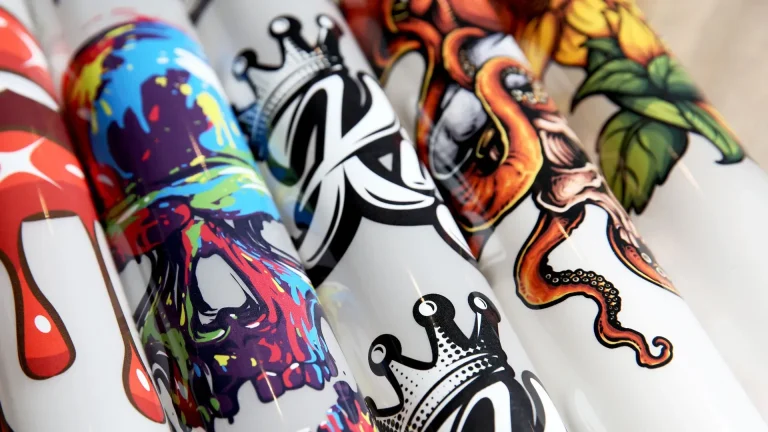DTF transfer, or Direct-to-Film transfer, has rapidly gained traction among custom printing enthusiasts and businesses alike, thanks to its remarkable quality and adaptability. This innovative printing method allows for intricate designs to be applied to various fabrics, making it ideal for custom apparel and promotional items. In this guide, we delve into essential DTF printing guidelines and offer actionable DTF transfer tips to enhance your projects’ success. By understanding key aspects such as heat settings for DTF and selecting the right DTF transfer materials, you can elevate the quality of your output. Whether you’re a seasoned professional or just starting, mastering DTF transfers is crucial for creating compelling and durable prints that stand out in the market.
Direct-to-Film transfer printing, often simply referred to as DTF printing, stands as a modern solution for high-quality printing challenges faced by custom design creators. This method involves printing directly onto a special film that is then transferred onto fabric, ensuring vibrant colors and intricate designs. By exploring alternative terms and concepts like film-based printing or heat transfer techniques, individuals can better navigate the nuances within this creative field. This article will cover vital points surrounding design dimensions, material selection, and optimal application techniques to facilitate effective DTF printing practices. Emphasizing the importance of correct heat settings and testing various fabrics will empower businesses to produce impressive, long-lasting products tailored to their clients’ needs.
Key Benefits of DTF Transfer Printing
DTF transfer printing has emerged as a game-changer in the world of custom apparel, thanks to its impressive capability to produce high-quality images that are both vibrant and durable. One of the primary benefits of using DTF transfers is the versatility they offer. This method allows for printing on a variety of fabrics, including cotton, polyester, and blends, making it ideal for different custom projects such as t-shirts, hoodies, or even bags. Moreover, DTF printing can replicate intricate designs with ease, ensuring that every detail is captured beautifully regardless of the fabric used.
Another significant advantage of DTF transfer printing is its ability to achieve a soft-hand feel on garments. Unlike traditional heat transfer methods that can leave a stiff texture, DTF transfers bond at the ink level with the fabric fibers, resulting in a lightweight finish that maintains the garment’s natural drape. This characteristic is especially appealing for customers who desire comfortable clothing. Additionally, the adhesion properties of DTF transfers make them more resilient to wear and tear, washing, and fading over time, enhancing the longevity of the printed designs.
Understanding DTF Printing Process
The DTF printing process begins with the creation of a digital design, which is then printed onto a special film using high-quality inks. The next step involves applying adhesive powder to the wet ink, which is then melted to create a strong bond when heat pressed onto the fabric. This multi-step approach allows DTF printing to achieve exceptional detail and color vibrancy, making it a popular choice for intricate designs. Understanding this process is crucial for anyone looking to delve into custom DTF printing, as each step significantly impacts the final product.
Furthermore, familiarity with best practices in DTF printing can elevate the quality of your outputs. Key parameters such as selecting the right film, adjusting ink density, and fine-tuning heat settings are essential for achieving the best possible results. For instance, using a high-quality DTF film ensures a clear transfer with minimal defects, while proper heat application can prevent damage to both the transfer and the fabric. Each aspect of the printing process plays a vital role in ensuring the durability and appearance of the final product.
Tips for Ensuring Perfect Design Size
When it comes to DTF transfers, getting the design size right is imperative for achieving optimal results. One of the foundational tips is to work with vector graphics whenever possible, as they can be resized without loss of quality. For raster images, maintaining a resolution of at least 300 DPI (dots per inch) is crucial to prevent pixelation when the design is enlarged or reduced. Test printing swatches at different sizes can help determine the best dimensions for your specific project, ensuring that your designs look crisp and clear on the final product.
Moreover, thoughtful placement of the design on the garment is equally important. The size and positioning can drastically change the visual appeal of the finished item. Experimenting with different placements can help identify how the design interacts with the garment’s cut and style. Additionally, considering the customer’s perspective is vital; customers might favor larger, bolder designs, especially on casual wear, while retaining the option for smaller, more subtle prints for formal items. Keeping these considerations in mind will enhance customer satisfaction and drive repeat business.
Finally, testing various configurations on different fabrics will equip you with valuable insights into how size impacts the final product. Factors such as texture and stretch can alter the perception of size, making it essential to tailor your approach for each material.
Choosing the Right Materials for DTF Printing
The fabric selection process stands as one of the most pivotal elements in successful DTF printing. Each textile reacts differently to the DTF transfer process; for instance, cotton is often favored for its soft, breathable qualities while polyester is chosen for its vibrant print acceptance. When selecting materials, it’s essential to consider both the aesthetic appeal and functionality of the final product. For instance, using blends can harness the strengths of both cotton and polyester, resulting in vibrant colors and a comfortable feel.
Furthermore, understanding fabric properties such as thickness, stretch, and texture will aid in selecting the ideal material for your DTF projects. Thicker fabrics like fleece or denim might require adjustments in heat settings or application time to ensure proper adhesion and prevent potential damage. Testing several materials before the final production run can substantially reduce the risk of errors and maintain quality standards, providing a solid foundation for successful custom DTF printing.
Mastering Temperature and Timing in DTF Transfers
Achieving the perfect heat settings is crucial for successful DTF transfers. The recommended temperature range for DTF printing typically falls between 320°F to 350°F. Accurate temperature control is essential; too much heat can damage the transfer or fabric, while too little may lead to incomplete adhesion. Using a digital heat press with precise settings is beneficial in achieving consistent results across different batches of prints, ensuring high-quality outcomes each time.
Additionally, timing plays a vital role in the process. The pressing time generally ranges from 10 to 15 seconds, varying according to the materials and sizes used. It’s important to monitor the time closely, especially when working with larger designs, as longer or shorter pressing times can lead to ineffective transfers. Performing test trials with various times and pressures can help identify the optimal settings for specific fabrics and transfer sizes, paving the way for seamless quality in all of your DTF printing efforts.
Maintaining Quality Post-Transfer
Post-pressing care is an invaluable aspect of the DTF printing process that often gets overlooked. After applying the transfer, it is advisable to allow at least 24 hours for the design to properly cure before washing the garments. This wait period is essential for ensuring that the adhesive fully bonds with the fabric, guaranteeing the longevity and durability of the print. Taking the time to allow the adhesive to set can significantly extend the life of the customized garments.
In addition to letting the transfers cure, providing clients with proper washing instructions is crucial for maintaining print quality. Recommend washing the garments inside out in cold water to protect the printed design from fading. Advise against using bleach, as this can severely compromise the colors, resulting in a diminished appearance. By educating customers on high-quality garment care, you can enhance client satisfaction and foster repeat business in the competitive realm of custom DTF printing.
Frequently Asked Questions
What are the essential DTF printing guidelines for beginners?
When starting with DTF transfers, focus on understanding the three core steps: printing on special film, applying adhesive powder, and heat pressing. Ensure your design is at least 300 DPI for clarity, choose the right fabric, and maintain optimal heat settings between 320°F and 350°F for best results.
What are some effective DTF transfer tips for optimizing design size?
To optimize your DTF transfer’s design size, always use vector formats when possible, conduct test swatches at different sizes, and ensure proper placement on garments. This helps maintain visual quality and ensures the design looks great, whether on t-shirts or bags.
How do I select the right DTF transfer material?
When choosing DTF transfer materials, consider the fabric type—cotton offers a soft feel while polyester provides vibrant color. Testing different fabrics also helps you determine how well they absorb inks and adhere to the adhesive used in DTF printing.
What heat settings are recommended for DTF transfers?
For successful DTF transfers, maintain a heat setting between 320°F and 350°F, pressing for about 10 to 15 seconds. Adjust your timing and pressure as needed for larger designs to ensure even adhesion during the heat press process.
What post-pressing care should I follow after a DTF transfer?
After completing a DTF transfer, wait at least 24 hours before washing to allow the adhesive to cure. When washing, turn the garment inside out and use cold water to preserve color vibrancy, avoiding bleach which can damage the print.
How can graphic design software aid in custom DTF printing preparation?
Graphic design software is vital for scaling designs and managing colors effectively for DTF printing. Familiarize yourself with software features that allow for layering and proper color separations, ensuring each section prints correctly and aligns during heat pressing.
| Key Point | Details |
|---|---|
| Understanding DTF Transfers | DTF printing involves printing on film, applying adhesive, and heat-pressing to fabric. |
| Sizing Your Design | Use vector-based designs, conduct test swatches, and consider design placement. |
| Material Considerations | Choose appropriate fabrics, test multiple materials, and consider stretch and feel. |
| Temperature and Timing | Optimal heat is between 320°F and 350°F, with pressing times of 10-15 seconds. |
| Post-Pressing Care | Wait 24 hours before washing and turn garments inside out to preserve prints. |
| Software and Preparation | Use design software for scaling and color separations to improve print accuracy. |
Summary
DTF transfer is an innovative technique in custom printing that allows for high-quality designs on various materials. By understanding the intricacies of design sizing, material compatibility, and proper pressing techniques, you can ensure vibrant, durable outputs for your custom printing projects. This method not only enhances the visual appeal of custom apparel but also contributes to the longevity of the prints. By following essential tips such as optimal design formatting and material testing, you will be better equipped to tackle unique printing challenges, impressing your clients with exceptional results.


